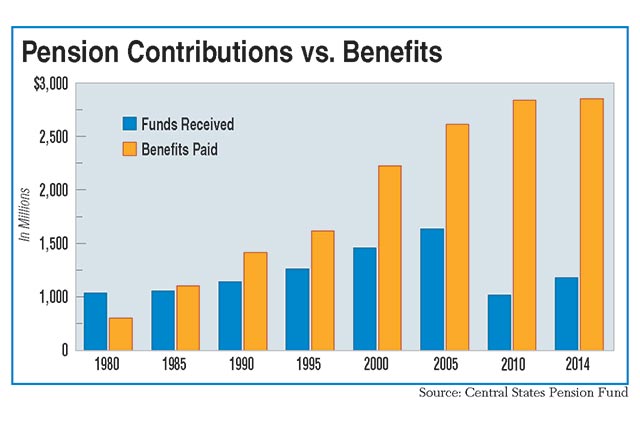With Union Pensions in Jeopardy, Fund Appeals to Congress for Aid

Thorny Teamsters pension issues were pushed into Congress’ lap last week by the Central States Pension Fund after the U.S. Treasury Department rejected the fund’s bid to create long-term solvency by cutting pension benefits by about 50% for most union retirees.
“Now is the time for [members of Congress] to step up to the plate and provide the funding required to save the Central States Pension Fund and the participants’ retirement benefits that are at risk,” said Thomas Nyhan, the fund’s executive director, who huddled with trustees in Chicago last week to decide what to do next.
His May 9 comments came one business day after the Treasury Department said the fund’s proposal to counter annual shortfalls of $2 billion failed to meet requirements of a 2014 pension reform law. The fund crafted the plan that would have hit hardest at retirees under age 75 in response to the recent annual $2 billion drawdowns. Resources dwindled to $16.1 bil- lion at the end of last year, a drop of more than $10 billion since 2007.
“They have promised our pension fund participants there is a better way to fix this critical problem,” said Nyhan, who contended that his plan’s rejection means only Congress or the federal Pension Benefit Guaranty Corp. can prevent a complete loss of member benefits.
However, there was no immediate sign that Republican leaders would convene hearings or otherwise act on two bills introduced last year to address the issue. The Republican-led Congress in 2014 approved the Kline-Miller Multiemployer Pension Reform Act that forced financially troubled funds such as Central States to submit rescue plans.
Those bills are the Pension Accountability Act from Sen. Rob Portman (R-Ohio) and Rep. David Joyce (R-Ohio) and the Keep Our Pension Promises Act by Sen. Bernie Sanders (I-Vt.) and Rep. Marcy Kaptur (D-Ohio).
Portman would change the ratification process if the Treasury Department approves a plan to base the outcome only on votes cast. Currently, the law counts those who don’t vote as supporters of a plan ratified by Treasury. Kaptur’s measure would scrap the 2014 measure.
Meanwhile, the Government Accountability Office is developing a report on pension issues that could provide solution options. It’s conducting a review of the Department of Labor’s oversight of the troubled fund sought by Sen. Charles Grassley (R-Iowa). A spokeswoman for the senator told Transport Topics that Grassley is waiting until the conclusion of the review before deciding what to do next. Other members who have spoken publicly about the issue either reiterated past views without saying how they would advance either bill or didn’t respond to requests for comment.
There also was no indication by press time of next steps by Central States Pension Fund, which pays $3.46 in benefits for each dollar contributed by active workers and their employers.
The rejected plan would have limited or exempted those over age 75 from cuts. It also would have reduced future benefits for active workers and raised the retirement age for full benefits to 65 from 62.
Central States’ application sparked thousands of incensed comments from union retirees, including some who have said they could lose their savings or homes.
Nearly 50,000 of those retirees would have absorbed even larger cuts under Central States’ plan because they were “orphans” whose carriers failed and didn’t keep up contributions. Nyhan has tied the plan’s financial plight to the 10,000 companies that have failed and stopped making contributions.
Among major carriers, only ArcBest’s ABF Freight and its workers make full pension contributions today. YRC Worldwide’s contributions are reduced as a concession to its past financial woes.
Nyhan offered other recommendations, urging all of the fund’s more than 400,000 participants to contact their congressional representatives and ask them to take “immediate action to protect our pension benefits.” He also urged the Teamsters, the Pension Rights Center and other groups that urged rejection of the Central States proposal “to demonstrate their muscle by helping to get rescue legislation passed.”
The Treasury Department’s special master, Kenneth Feinberg, who previously handled claims for Sept. 11 victims, said May 6 that the plan failed to meet three requirements of the 2014 law. He cited inaccurate future solvency assumptions, a failure to distribute cuts equitably and sending to members communications that weren’t readily understandable, including a 98-word sentence.
Nyhan disputed Feinberg, saying 73% of retirees surveyed said the benefit-cuts letter was easy to understand. He also defended Central States’ calculations of benefit cuts and future fund balances, and noted that there was just one example of inequitable distributions.
“If Treasury is going to make such a sweeping claim, they should cite all areas of the application where they believe we fell short,” Nyhan said.
That one example was for UPS Inc. workers. A total of 43,000 UPS retirees still are receiving benefits from the fund. UPS paid $6.1 billion to exit the fund, but terms of that deal required the company to make up for future benefit reductions for most of its Central States retirees.

